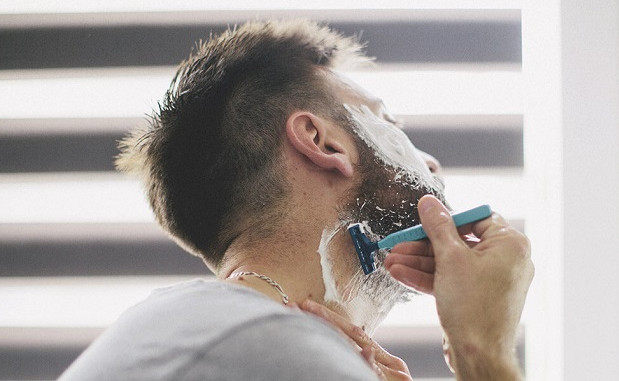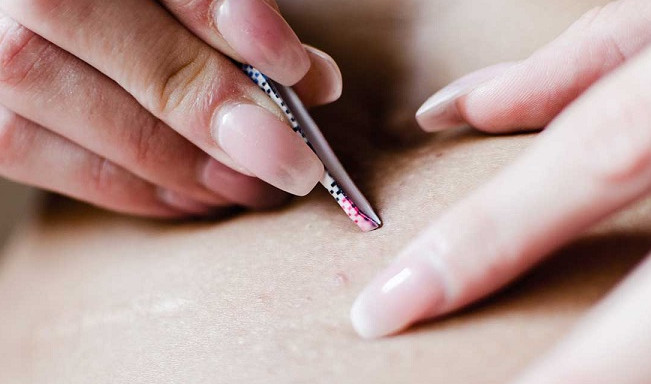Causes, treatments, and prevention of subcutaneous hair
Subcutaneous hair occurs when body hair grows back into the skin after being shaved or pulled out. Inflammation, pain, and small bumps may appear in the area where the hair was removed in these conditions. There are methods for reducing subcutaneous hair, which is almost common. Stay with us until the end of this article to discover the causes and prevention methods of this condition.

How do you define subcutaneous hair?
A subcutaneous hair problem occurs when body hair grows under the skin instead of on top. After shaving, pulling, or waxing, this occurs. There will be a small round bump or boil filled with purulent secretions in this case. It is not uncommon for the skin around the subcutaneous hair to be darker.
You may experience pain or itching in the areas affected by this complication. Some people are more prone to this than others. Ingrown hairs are more common in people with thick, curly hair than in people with thin, light hair. Pubic hair is also more prone to this phenomenon due to its coarser texture.
Subcutaneous hair grows for the following reasons:
The main cause of this condition is the structure and direction of hair growth. A curved hair follicle increases the chance of hair entering the skin after regrowth. Especially if the hair is dry when shaved, this type of hair produces sharp edges.
Ingrown hairs can also be caused by these conditions:
While shaving, pull the skin firmly to pull the shaved hair into the skin.
Tweezers may cause a part of the hair to stick under the skin when plucking hair with them.
An inflammatory response occurs when the hair enters the skin as a foreign body.
Subcutaneous hair treatment
Most of the time, this complication does not require treatment and disappears on its own. You may need to take these steps if the hair does not grow above the surface of the skin.
- In that area, do not remove the hair
In this area, do not shave or pull out the hair until the subcutaneous hair is gone. This sensitive area will become more irritated if you continue to shave. Scratching and manipulating the hair under the skin may also worsen the symptoms. A skin infection or ulcer may result.
- Warm compresses can be used
Apply a warm compress to the affected area. Periodically apply a wet towel or a soft toothbrush to the skin.
- Gently remove the hair
Treating subcutaneous hair with tweezers is recommended . When the hair reaches the surface of the skin, gently pull it out with sterile tweezers or a needle. The skin will heal over the hair once the area is fully healed, so try not to pull it out until the area is completely healed. In order to reach the hair, do not break the skin.
- Dead skin should be removed
Wash and exfoliate the skin around the subcutaneous hair until the hair reaches the surface. Dead skin may be easier to remove with medication if that doesn’t work.
- Creams can reduce inflammation
Your doctor may prescribe steroid cream or ointment if the ingrown hair causes a lot of redness and inflammation. Inflammation and irritation around the hair can be reduced with this topical treatment.
- Retinoids should be used
Dead skin can be shed more quickly with retinoids. Additionally, they help remove dark spots caused by this condition. These drugs require a prescription from your doctor, and you should be aware that they cause dry skin.
Pregnant women should not use retinoids. During pregnancy, these drugs can harm the fetus and cause birth defects.
If ingrown hairs are not treated, what happens?
Ingrown hairs usually fall out of the skin after a week or two, causing little discomfort. Symptoms of an infection around this hair include pus, discoloration, and pain. See a doctor if you experience these symptoms.

Infections of the subcutaneous hair can be treated at home
This condition can be improved and prevented with over-the-counter medications and home remedies. Below are some examples of these treatments.
- Drugs that do not require a prescription
Salicylic acid exfoliates the skin. The products prevent hair follicles from getting stuck under the skin again. These medications may irritate ingrown hairs, so you should not use them if you have them.
A moisturizer without oil removes dead skin cells that block follicles and cause ingrown hairs.
- Treatment at home
Inflammation is reduced and bacteria are killed by tea tree oil. Ingrown hairs can also be treated with this combination. Tea tree oil should be diluted with water and applied to the affected area with cotton.
Natural exfoliating sugar can be mixed with olive oil or honey to hydrate the skin and kill bacteria. Wash the area with warm water after applying this paste.
Exfoliating and reducing inflammation of the skin can be accomplished with baking soda. Add 1 tablespoon of baking soda to 1 glass of water. Wash your face with cold water after applying it with cotton.
Subcutaneous hair prevention:
- Before shaving, prepare the desired area
By preparing the intended areas before shaving, this complication can be reduced. Wash the skin with mild soap first. Apply shaving gel or paste to the skin. Make sure this area is completely dry after finishing work and before getting dressed.
- Laser hair removal may be a good option
Despite the fact that laser hair removal is expensive, it is a long-term solution to prevent ingrown hairs. Lasers remove hair from a deeper layer and damage the hair follicles. Most of the time, this will prevent the hair from growing back.
Laser hair removal requires several treatments over several weeks and months, but the results are almost permanent. Blonde or very light hair is less likely to benefit from this method.
- Chemical epilators are one option, but they can irritate sensitive skin. Test the shaver on a small area of skin other than the genital area first. Do not stop using these ingredients if you do not have a reaction within 24 hours.
Genital skin is much more sensitive than skin on the hands or buttocks. Some creams can also reduce hair regrowth after laser and other hair removal procedures.
Permanent hair removal can be achieved through electrolysis. Electrodes are used to remove the hair root with this method. Like laser therapy, electrolysis requires several treatments over several weeks or months.
What is the best time to see a doctor?
There’s nothing to worry about if you notice an ingrown hair every now and then. The prevention methods mentioned above can help you avoid this complication. If you experience any of the following symptoms, you should see a doctor:
Ingrown hairs are common. In order to prevent recurrence, the doctor can suggest treatments.
There is too much excess hair on you. There may be a health problem behind this.
As a final note
Any part of the body with hair can develop subcutaneous hair, one of the most common skin conditions. The condition usually affects areas that are shaved and the hair is removed with tweezers or wax, especially the face, legs, armpits, and genital area. Ingrown hairs can be prevented and treated quickly with proper skin care. The home methods introduced here can easily help you get rid of these annoying hairs and give you a healthy, even complexion.


